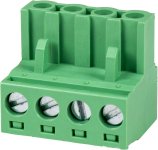I have seen audio equipment that is designed to accept connectors like the one shown below (which has a 5mm pitch). I’ve heard it called a “euroblock” connector. I am trying to find connectors that mate with the one shown. I'd use them on the back of some of my DIY equipment. I’d like to get some six-position (i.e., six pin) bulkhead connectors. Some of the ones I have found don’t look like they would work (e.g., there is a septum between each pin).
Can anyone help me with a link the right connectors? It would be fine if they had solder lugs for connection. I could use connectors that require a rectangular hole in the chassis, but I’d have to saw the hole out and the file it to size. If there are connectors that mount on a bulkhead but do not require a large rectangular hole (multiple small holes instead?) that would be great.
If you can help me with the search terms for such a connector, I can try to find the ones that are best suited for my needs.
Thanks
Tom
Can anyone help me with a link the right connectors? It would be fine if they had solder lugs for connection. I could use connectors that require a rectangular hole in the chassis, but I’d have to saw the hole out and the file it to size. If there are connectors that mount on a bulkhead but do not require a large rectangular hole (multiple small holes instead?) that would be great.
If you can help me with the search terms for such a connector, I can try to find the ones that are best suited for my needs.
Thanks
Tom
Attachments
Another option is to look at automotive connectors, like tail lamp connectors, most would have wires, though.
Thanks for the replies. I had to use a micrometer and two pairs of reading glasses, but discovered that my terminal pitch is 5.08mm (0.4 inches for two spaces).
I started searching and found an informational article here: https://www.prosoundtraining.com/2018/02/15/useful-tips-euroblock-connectors/
The article states "A one position Euro has three electrical contacts." The example provided by tomchr above, Molex P/N: 39532-6005 on the Mouser website shows in the specifications to to have 5 positions and the picture shows 5 pins. This makes me doubtful that 1 position = 3 pins. The data sheet for that part allows dimensions to be looked up for various numbers of pins (called "circuit size" on the datasheet). The space between outside pins should be the (number of pins minus 1) multiplied by the pitch, and this only works if 1 position equals 1 pin. So it is not the case that 1 position = 3 contacts.
I am still confused on one point.
In the above linked article, see the photo to illustrate pitch (attached here).
Note that the connector being measured has no gaps between pins; the entire width of the female connector inserts into the male. There can be no obstructions between the pins.
Note also in the same photo the illustration of pitch difference as seen in the red ellipse. In these connectors each pin is independently housed so that there is a clear space (gap) between pins.
The article also shows a picture with two examples of audio equipment to illustrate differences in pinouts. Note that for both of these examples, each pin is in its own rectangle; there is a septum between the pins. It looks to me like this connector would not accept the one being measured in the first photo. (Am I missing something?) Is there a naming convention to distinguish between these two types?
I am now on the path to finding the connector I want, thanks to all. I will take a look at taillight connectors - perhaps for another project (non-audio) where the attached wires would be desirable.
Tom
I started searching and found an informational article here: https://www.prosoundtraining.com/2018/02/15/useful-tips-euroblock-connectors/
The article states "A one position Euro has three electrical contacts." The example provided by tomchr above, Molex P/N: 39532-6005 on the Mouser website shows in the specifications to to have 5 positions and the picture shows 5 pins. This makes me doubtful that 1 position = 3 pins. The data sheet for that part allows dimensions to be looked up for various numbers of pins (called "circuit size" on the datasheet). The space between outside pins should be the (number of pins minus 1) multiplied by the pitch, and this only works if 1 position equals 1 pin. So it is not the case that 1 position = 3 contacts.
I am still confused on one point.
In the above linked article, see the photo to illustrate pitch (attached here).
Note that the connector being measured has no gaps between pins; the entire width of the female connector inserts into the male. There can be no obstructions between the pins.
Note also in the same photo the illustration of pitch difference as seen in the red ellipse. In these connectors each pin is independently housed so that there is a clear space (gap) between pins.
The article also shows a picture with two examples of audio equipment to illustrate differences in pinouts. Note that for both of these examples, each pin is in its own rectangle; there is a septum between the pins. It looks to me like this connector would not accept the one being measured in the first photo. (Am I missing something?) Is there a naming convention to distinguish between these two types?
I am now on the path to finding the connector I want, thanks to all. I will take a look at taillight connectors - perhaps for another project (non-audio) where the attached wires would be desirable.
Tom
